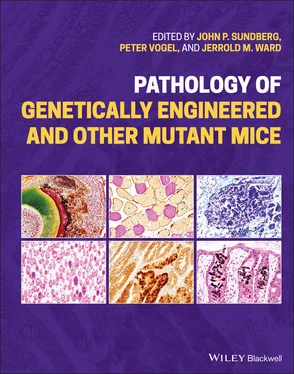Pathology of Genetically Engineered and Other Mutant Mice
Здесь есть возможность читать онлайн «Pathology of Genetically Engineered and Other Mutant Mice» — ознакомительный отрывок электронной книги совершенно бесплатно, а после прочтения отрывка купить полную версию. В некоторых случаях можно слушать аудио, скачать через торрент в формате fb2 и присутствует краткое содержание. Жанр: unrecognised, на английском языке. Описание произведения, (предисловие) а так же отзывы посетителей доступны на портале библиотеки ЛибКат.
- Название:Pathology of Genetically Engineered and Other Mutant Mice
- Автор:
- Жанр:
- Год:неизвестен
- ISBN:нет данных
- Рейтинг книги:3 / 5. Голосов: 1
-
Избранное:Добавить в избранное
- Отзывы:
-
Ваша оценка:
- 60
- 1
- 2
- 3
- 4
- 5
Pathology of Genetically Engineered and Other Mutant Mice: краткое содержание, описание и аннотация
Предлагаем к чтению аннотацию, описание, краткое содержание или предисловие (зависит от того, что написал сам автор книги «Pathology of Genetically Engineered and Other Mutant Mice»). Если вы не нашли необходимую информацию о книге — напишите в комментариях, мы постараемся отыскать её.
An updated and comprehensive reference to pathology in every organ system in genetically modified mice Pathology of Genetically Engineered and Other Mutant Mice
Pathology of Genetically Engineered and Other Mutant Mice
Pathology of Genetically Engineered and Other Mutant Mice — читать онлайн ознакомительный отрывок
Ниже представлен текст книги, разбитый по страницам. Система сохранения места последней прочитанной страницы, позволяет с удобством читать онлайн бесплатно книгу «Pathology of Genetically Engineered and Other Mutant Mice», без необходимости каждый раз заново искать на чём Вы остановились. Поставьте закладку, и сможете в любой момент перейти на страницу, на которой закончили чтение.
Интервал:
Закладка:
Mutagenesis using targeted endonuclease‐cleavage technologies (CRISPR, Zinc Finger endonuclease, or TALEN) create site‐targeted genomic changes by either non‐homologous end joining resulting in random indels (insertion/deletions), or homologous recombination with a donor plasmid to generate specific sequence alterations (floxed, point mutations, insertion of exogenous sequence, etc.). While there is no standard for naming endonuclease‐mediated mutations across species, mouse, rat, and Xenopus designate such mutation with “em” [48] followed with the serial number of endonuclease‐mediated mutation for the generating laboratory, and the ILAR‐registered laboratory code (e.g. Abcb1a em1Sbkvfor endonuclease‐mediated mutation 1 from the laboratory of Dr. Sergei B Koralov in adenosine triphosphate (ATP)‐binding cassette, sub‐family B [MDR/TAP], member 1A gene) [49]. Endonuclease‐mediated mutation nomenclature mirrors targeted allele nomenclature in regard to inserted expressed sequences ( http://www.informatics.jax.org/mgihome/nomen/gene.shtml#endim). When endonuclease‐mediated mutations are used to produce multigenic mutations either through direct targeting or recombination between previously targeted sites, chromosomal aberration nomenclature is used in the absence of a marker designating the region affected (to be added to the nomen webpage). For example, Del(5Kit‐Nmu)2Staka (deletion, Chr 5, Satoru Takahashi 2) describes the 1.07 Mb deletion produced by CRISPR/Cas targeting of a region 240 kb upstream of Kit and 81 kb downstream of Nmu [50].
Gene trap alleles are produced by random integration of constructs containing splice acceptors and other sequences that prematurely terminated transcription disrupting gene expression [51]. Alleles generated by the integration of a gene trap are represented with “Gt,” the mutant cell line in parenthesis, and ILAR‐registered laboratory code. For example, in Dnajb9 Gt(KST256)Byg(gene trap KST256 from BayGenomics in DnaJ heat shock protein family [Hsp40] member B9), a gene trap with a splice donor and β‐galactosidase gene is inserted into intron producing a hypomorphic allele [52].
Enhancer traps are specialized transgenes. One utility of these transgenes is in creating cre ‐recombinase driver lines. Enhancer traps of this type that are currently being created may include a minimal promoter, introns, a cre ‐recombinase cassette (sometimes fused with another element such as ERT2), and polyA sites from different sources. Nomenclature for these enhancer traps consists of 4 parts as follows: Et, prefix for enhancer trap; cre recombinase cassette, portion in parentheses (for example, cre, icre, or cre/ERT2 [if fused with ERT2]); line number or serial number to designate lab trap number or serial number; Lab code: ILAR code identifying the creator of this enhancer trap; Examples include: Et(icre)754Rdav (for Enhancer trap 754, Ron Davis) and Et(cre/ERT2)2047Rdav (for Enhancer trap 2047, Ron Davis) [53].
Transposon‐induced mutations utilize transposases (e.g. sleeping beauty) to mobilize integrated transposon concatemers flanked by long terminal repeats (LTR) to insert into small base pair recognition sequences [54]. When integration of the transposon does not disrupt the LTR, these elements can be remobilized and “hop” into different sites located either on the same chromosome or a different one. Transposons can insert sequences to be expressed as well as disrupting gene expression at integration site. Transposon‐induced alleles are denoted with “Tn,” the transposon concatemer (specifying the transposase), a line number (followed by a period “.” and additional serial number in the case of remobilization), and ILAR‐registered laboratory code. In the transposon‐induced mutation Slc16a10 Tn(sb‐lacZ,GFP)1.4Tcb(line 4 containing reintegration of a sleeping beauty‐specific transposon that expressed lacZ and GFP from Dr. Thomas Brodnicki), transposition of the expression cassette into intron 1 produces a null allele [55].
In many cases, a large number of transgenic lines are made from the same gene construct and only differ by tissue specificity of expression. The most common of these are transgenes that use reporter constructs or recombinases (e.g. GFP, lacZ , cre ), where the promoter should be specified as the first part of the gene insertion designation, separated by a hyphen from the reporter or recombinase designation. The SV40 large T antigen is another example. The use of promoter designations is helpful in such cases. Examples include Tg(Wnt1‐LacZ)206Amc, in which the mouse has a LacZ transgene with a wingless‐type mouse mammary tumor virus (MMTV) integration site family, member 1 ( Wnt1 ) promoter, from mouse line 206 created in the laboratory of Andrew McMahon [56]. Another example is Tg(Zp3‐cre)3Mrt in which the cre transgene has a zona pellucida glycoprotein 3 ( Zp3 ) promoter, the third transgenic mouse line from the laboratory of Gail Martin [57].
Summary
Mouse genetic nomenclature can be confusing at first, and is often considered to be unimportant by investigators. However, there are many sources of help and support, discussed above, and the effort needed to become fluent in the language of strains and mutants is much less than the potential effort needed to rescue badly planned experiments or recoup the costs involved in using the wrong mice. It is also essential for the replication of experiments, both yours and those whose resources you intend to use, and the sharing of your data. We hope that this commentary lays out clearly why an appreciation and functional knowledge of nomenclature is not only helpful but essential for those using mice as a model system.
Acknowledgments
This work was supported in parts by grants from the National Institutes of Health (R01 CA089713 and HG000330).
References
1 1 McKusick, V.A. (1969). On lumpers and splitters, or the nosology of genetic disease. Perspect Biol. Med. 12 (2): 298–312.
2 2 Simon‐Sanchez, J. and Gasser, T. (2015). Parkinson disease GWAS: the question of lumping or splitting is back again. Neurology 84 (10): 966–967.
3 3 Schofield, P.N., Bubela, T., Weaver, T. et al. (2009). Post‐publication sharing of data and tools. Nature 461 (7261): 171–173.
4 4 Low, B.E., Kutny, P.M., and Wiles, M.V. (2016). Simple, efficient CRISPR‐Cas9‐mediated gene editing in mice: strategies and methods. Methods Mol. Biol. 1438: 19–53.
5 5 Snell, G.D. (1941). Biology of the Laboratory Mouse, 1e. New York, NY: McGraw‐Hill.
6 6 Husler, M.R., Beamer, W.G., Boggess, D. et al. (1998). Neoplastic and hyperplastic lesions in aging C3H/HeJ mice. J. Exp. Anim. Sci. 38 (4): 165–180.
7 7 Sundberg, J.P., King, L.E. Jr., Bosenberg, M. et al. (2020). Animal models of skin disease. In: McKee's Pathology of the Skin with Clinical Correlations. 2, 5e (eds. E. Calonje, T. Brenn, A.H. Lazar and S.D. Billings), 1895–1917. China: Elsevier.
8 8 Li, Q., Berndt, A., Sundberg, B.A. et al. (2016). Mouse genome‐wide association study identifies polymorphisms on chromosomes 4, 11, and 15 for age‐related cardiac fibrosis. Mamm Genome. 27 (5‐6): 179–190. https://doi.org/10.1007/s00335‐016‐9634‐y. Epub 2016 Apr 28.
9 9 Giehl, K.A., Potter, C.S., Wu, B. et al. (2009). Hair interior defect in AKR/J mice. Clin. Exp. Dermatol. 34 (4): 509–517.
10 10 Wu, B., Potter, C.S., Silva, K.A. et al. (2010). Mutations in sterol O‐acyltransferase 1 (Soat1) result in hair interior defects in AKR/J mice. J. Invest. Dermatol. 130 (11): 2666–2668.
11 11 Davisson, M.T., Schmidt, C., Reeves, R.H. et al. (1993). Segmental trisomy as a mouse model for Down syndrome. Prog. Clin. Biol. Res. 384: 117–133.
Читать дальшеИнтервал:
Закладка:
Похожие книги на «Pathology of Genetically Engineered and Other Mutant Mice»
Представляем Вашему вниманию похожие книги на «Pathology of Genetically Engineered and Other Mutant Mice» списком для выбора. Мы отобрали схожую по названию и смыслу литературу в надежде предоставить читателям больше вариантов отыскать новые, интересные, ещё непрочитанные произведения.
Обсуждение, отзывы о книге «Pathology of Genetically Engineered and Other Mutant Mice» и просто собственные мнения читателей. Оставьте ваши комментарии, напишите, что Вы думаете о произведении, его смысле или главных героях. Укажите что конкретно понравилось, а что нет, и почему Вы так считаете.












